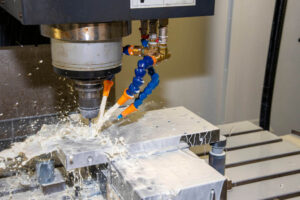45
This material is a high-quality carbon structural steel and the most commonly used medium carbon quenched and tempered steel.
Main features: The most commonly used medium carbon quenched and tempered steel has good comprehensive mechanical properties, low hardenability, and is prone to cracks during water quenching. Small pieces should be quenched and tempered, and large pieces should be normalized.
Application example: Mainly used to manufacture high-strength moving parts, such as turbine impellers, compressor pistons. Shafts, gears, racks, worms, etc.
Q235A (A3 steel)
This material is the most commonly used carbon structural steel.
Main features: It has high plasticity, toughness and welding performance, cold stamping performance, as well as certain strength and good cold bending performance.
Application examples: Widely used for general requirements of parts and welded structures. Such as tie rods, connecting rods, pins, shafts, screws, nuts, ferrules, brackets, machine bases, building structures, bridges, etc.
40Cr
This material is one of the most widely used steel grades and is an alloy structural steel.
Main features: After quenching and tempering treatment, it has good comprehensive mechanical properties, low temperature impact toughness and low notch sensitivity, good hardenability, high fatigue strength can be obtained when oil cooling, and parts with complex shapes are easy to be obtained when water cooling. Cracks, medium cold bending plasticity, good machinability after tempering or quenching Carbonitriding and high frequency surface hardening are carried out.
Application example: After quenching and tempering, it is used to manufacture medium-speed and medium-load parts, such as machine tool gears, shafts, worms, spline shafts, thimble sleeves, etc. Grinding parts, such as gears, shafts, main shafts, crankshafts, mandrels, sleeves, pins, connecting rods, screws and nuts, intake valves, etc., are used to manufacture heavy-duty, medium-speed impact after quenching and medium-temperature tempering. Parts, such as oil pump rotors, sliders, gears, spindles, collars, etc., are used to manufacture heavy-duty, low-impact, wear-resistant parts after quenching and low-temperature tempering, such as worms, spindles, shafts, collars, etc., carbon The nitriding part is used to manufacture transmission parts with larger size and higher low temperature impact toughness, such as shafts and gears.
HT150 gray cast iron
Gray cast iron is a type of cast iron. Most or all of the carbon in this cast iron exists in free state flake graphite, and its fracture is gray, so it is called gray cast iron.
Main features: good casting, cutting performance, good wear resistance. The graphite of gray cast iron is flake, the effective bearing area is relatively small, and the graphite tip is prone to stress concentration, so the strength, plasticity and toughness of gray cast iron are lower than other cast irons. But it has excellent vibration damping, low notch sensitivity and high wear resistance.
Application examples: gear box, machine bed, box, hydraulic cylinder, pump, valve, flywheel, cylinder head, pulley, bearing cover, etc.
35
This material is a common material for various standard parts and fasteners.
Main features: Appropriate strength, good plasticity, high cold plasticity and acceptable weldability. Local upsetting and wire drawing can be performed in the cold state. Low hardenability, use after normalizing or quenching and tempering.
Application example: It is suitable for the manufacture of small section parts and parts that can bear large loads: such as crankshafts, levers, connecting rods, shackles, etc., various standard parts and fasteners.
65Mn
This material is the most commonly used spring steel.
Main features: After heat treatment and cold drawing hardening, the strength is relatively high, and it has certain flexibility and plasticity; under the same surface state and complete hardening, the fatigue limit is comparable to that of the multicolored alloy spring. However, the hardenability is very poor, and it is mainly used for small-sized springs, such as pressure-regulating and speed-regulating springs, force-measuring springs, circular and square coil springs in general machinery, or drawn steel wires as springs in small machinery.
Application example: small size various flat and round springs, seat springs, spring springs, can also be made into spring rings, valve springs, clutch reeds, brake springs, cold coil springs, circlips, etc.
Cr12
This material is commonly used cold work die steel.
Main features: Cr12 steel is a widely used cold work die steel, which is a high-carbon and high-chromium ledeburite steel. The steel has good hardenability and good wear resistance; because the carbon content of Cr12 steel is as high as 2.3%, the impact toughness is poor, it is easy to be brittle, and it is easy to form uneven eutectic carbides;
Application example: Due to its good wear resistance, Cr12 steel is mostly used to manufacture cold punches, punches, blanking dies, cold heading dies and cold extrusion dies that require high wear resistance with less impact load. Dies, drill sleeves, gauges, wire drawing dies, stamping dies, thread rolling plates, deep drawing dies and cold stamping dies for powder metallurgy, etc.
Hope the above content can help you.




